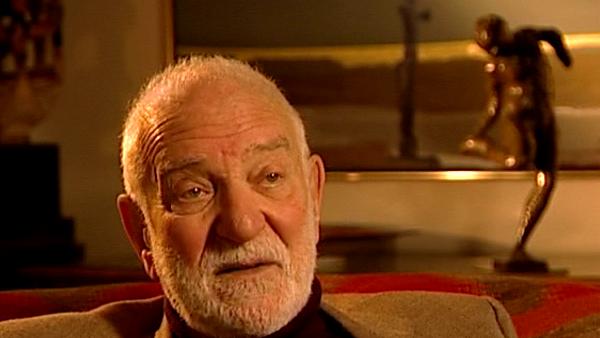NEXT STORY

The struggle in art
RELATED STORIES

NEXT STORY

The struggle in art
RELATED STORIES


|
Views | Duration | |
|---|---|---|---|
| 31. Inspiration from paintings | 228 | 06:23 | |
| 32. My first visit to Greece | 123 | 01:18 | |
| 33. Greek art made real | 116 | 03:55 | |
| 34. Travel and sculpture: Medicine Hat | 105 | 03:42 | |
| 35. Working in ceramic clay with Hans Spinner | 383 | 04:00 | |
| 36. The Trojan War | 205 | 04:18 | |
| 37. The Last Judgement | 212 | 04:05 | |
| 38. Sculpture is my life | 144 | 02:09 | |
| 39. My sense of rhythm | 155 | 04:08 | |
| 40. You need to show your work | 103 | 01:44 |


You've got to get your work out because it's so depressing not to. It's so depressing: make a sculpture, send it to the store and you don't see it again for ten years. It's very depressing, that, and you don't feel that you... you've done only half the story. So, the other half of the story is for people to see it.
[Q] OK, but what about you make a work, someone buys it, it goes to their private house? It's the same thing as it going to a store, isn't it? Doesn't...?
Yes, very much, very much and... and disappointing in a way. I would like to have it shown properly first so, in a way, you know, the... most shows which are chronological – they're not... unless they’re retrospectives, you know. It's like the last bit of making the stuff so you make the stuff, you write it in your book and you write the... the date of it and the size of it and the... the paint you used or whatever. And you have a photograph taken of it. And then the last of those equally pedestrian things usually is having a show of it. Then I think... then it can go its own merry way, but I don't think... it's not to me as real and as important as looking at it and saying it's right, you know, that's it.
[Q] Do you learn from exhibitions? Do you look at work with a distance and think, ‘Oh yeah, I see what I did there and I know...?
Sometimes but not much... not much. I learn a little bit from retrospective... and restrospect and saying, ‘Yes, well, you know, there was something fresh about those colour sculptures that was interesting’, you know. And... but I don't think you learn much from the past, no.
British sculptor Sir Anthony Caro (1924-2013) came to prominence in 1963 after a show at the Whitechapel Gallery. Keen to create a more direct interaction with the viewer he placed pieces directly on the ground, rather than on plinths, a technique now widely used. He held many honorary degrees and was knighted in 1987.
Title: You need to show your work
Listeners: Tim Marlow
Tim Marlow is a writer, broadcaster and art historian. He founded "Tate: The Art Magazine" in 1993 and was presenter of Radio 4 arts programme "Kaleidoscope" from 1991 to 1998, for which he won a Sony Award. He has presented art programme's on BBC 1, Channel 4 and Channel 5, including a documentary about JMW Turner, and written about art and culture for various British newspapers and magazines including "The Guardian", "The Times" and "Blueprint" He is Director of Exhibitions at the White Cube gallery in London as well as a visiting lecturer at Winchester School of Art, an examiner on the Sculpture MA there and former creative director of Sculpture at Goodwood
Tags: exhibitions, presenting art, retrospect
Duration: 1 minute, 44 seconds
Date story recorded: November 2005
Date story went live: 24 January 2008